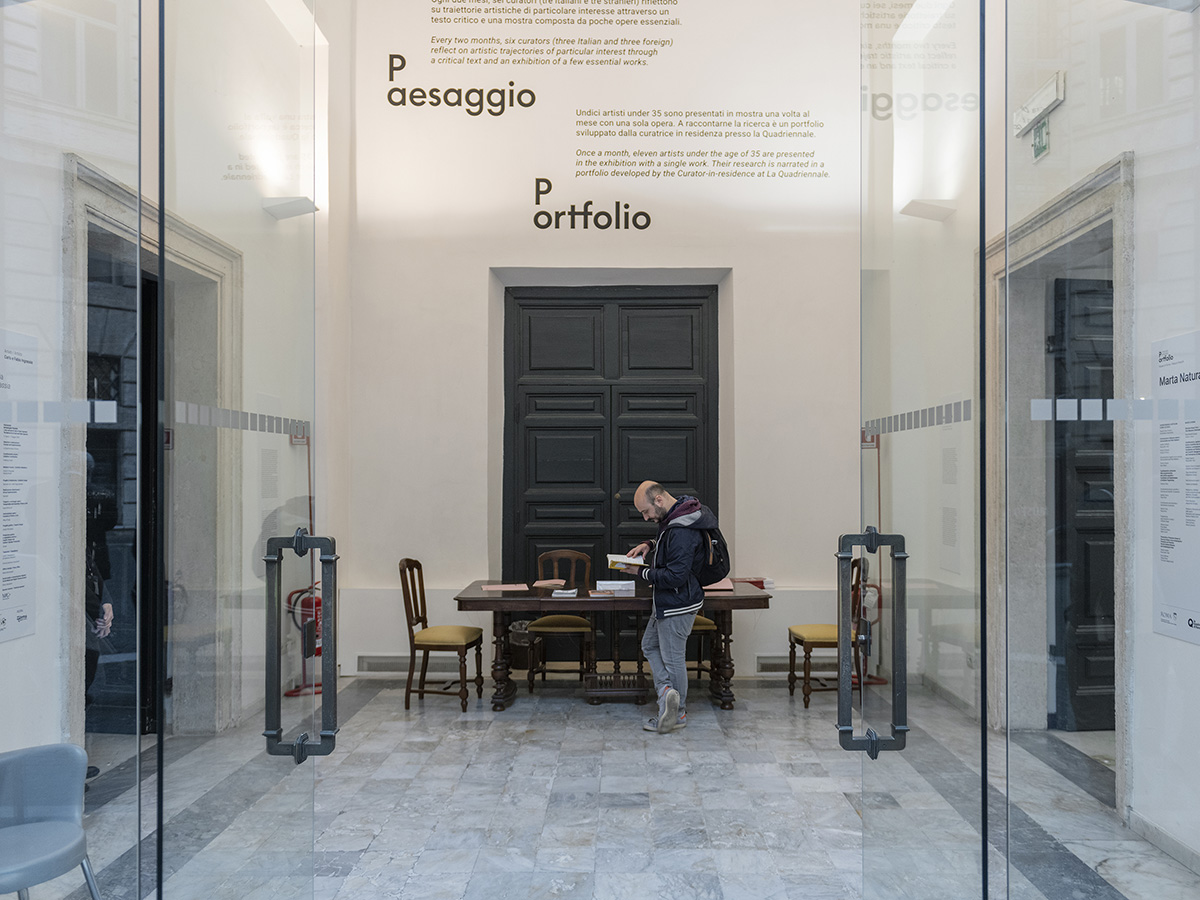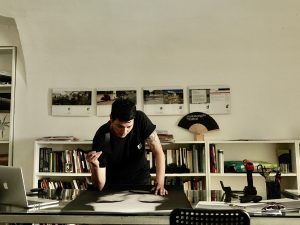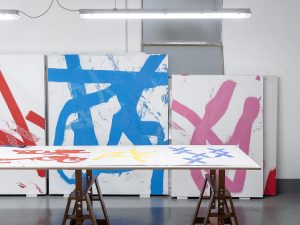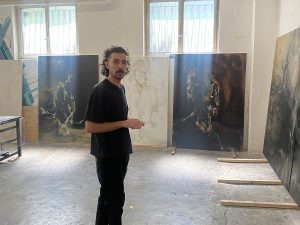Nicolas Ballario: It seems that between being and not being, Italy as a country prefers to be a has-been. Are we stuck in our ways, or short-sighted?
Gian Maria Tosatti: Italy is a country that has slowly let go of its control over the state. The very existence of a political class, be it good or bad, contradicts the idea that the running of the state responds to the concept of ‘service’. In the hands of a few, politics ends up being an exercise in power. But the responsibility — like sovereignty — always lies with the people and its sometimes believing that democracy means nothing more than voting once every five years. It has to be said that without participation, a country is no longer a state. It becomes, simply, a territory, on which not citizens, but inhabitants reside.
NB: Is what’s missing a more ongoing exercise of civic ‘duty’?
GMT: Well, democracy needs to be practiced daily. That’s obvious. What would happen if we showed up at a stadium once every five years to play a match, without ever doing a training session? People would laugh at us.
NB: It seems that your directorship in the Quadriennale developed from a similar observation.
GMT: Personally, I do not believe that you can hold an exhibition every four years without needing also to show that this ‘statement’ is the result of an intensive, ramified process, carried forward on a scholarly basis for each of the 1,440 days leading up to it. So, under my artistic direction and under the presidency that has placed its confidence in me, the Quadriennale has begun to change in order to build its credibility. We have not carried out any revolution. We have only developed the tools that were given to us by our own statute. And, it seems to me, this has had consequences for the whole system.
NB: In what sense does all this have a critical value?
GMT: It’s actually very simple: We have established a working method. Every day of the year, one of our curators scattered across the various regions of Italy visits an artist and compiles a critical file on their work, which is published on our website. If elements of particular interest emerge from this file, then the artist in question is also brought to the attention of the curators in other territories, so that one of them can visit them again, a few months later, and offer us a cross-check via a different critical file. If this further report confirms the quality of what has been observed, then the artist is referred to the other seven project areas active in our institution, whose leaders will work out what can be done to champion their work.
NB: Let’s stick to the critical aspect: tell me about the process, the steps, the means by which this is done.
GMT: Each step involves a selection that sets a third or fourth critic to studying the artist’s practice and then addressing it in their own work. In addition to the project area dedicated to the construction of the Panorama of Italian art, we have another dedicated to publishing, which works using different tools. The Quaderni d’arte italiana are one of these, and represent the possibility of contextualising the most interesting artists’ practices in broader horizons and narratives, in relation to both Italian and international art. Then there are other, even more properly scientific publications, which are the product of research grants commissioned through another of this institution’s project areas, i.e. the one devoted to the university arena. This area, coordinated by Raffaella Perna, has seen a postdoctoral research grant awarded each year, dedicated to the construction of lines of interpretation regarding 21st century Italian art. Each year, a researcher is salaried for twelve months to produce a publication that the Quadriennale produces and distributes. But this project area’s work also produces a series of inter-university seminars that aim to connect doctoral students and help them work as a team, sharing bibliographies and research results that can be intersected. This allows us to develop a widespread, shared knowledge about the work of young Italian researchers and to make them aware of our results.
NB: This points in the direction of bridging a gapbetween academia and the world of art criticism. Does this offer an opportunity for exchange?
GMT: Certainly. We do our part for such an exchange by publishing the best doctoral theses produced in Italy, year after year, on topics that pertain to our mission. This brings academic research out of its somewhat self-enclosed world, giving it a certain popularity, and at the same time it encourages universities to pay more attention to contemporary Italian art. Our digital art project area, coordinated by Valentino Catricalà, has also set up a postdoctoral research grant to investigate developments in applied technologies in the arts, and has also carried out a series of residencies in collaboration with the School of Digital Arts at Manchester Metropolitan University. This allowed young Italian artists to develop their research with highly advanced tools. The artists chosen always come from our monitoring work across the different territories, but they also go through further selection commissions. This is another way to champion their work.
NB: You have created a full programme of exhibitions, but the Quadriennale’s task is to do research. Is the institution turning into a museum?
GMT: No. In fact, our busy exhibition programme still stems from research projects whose main outcome is the development of critical essays. Technically, the exhibitions we produce are actually ‘illustrations’ of these investigation processes.
NB: You have two types of programme, right?
GMT: Yes. The first is the Portfolio project, which is the typical third link in the chain of observations on Italian art that starts with the wider monitoring effort. The artists recommended by the various critics on the ground arrive on the desk of Gaia Bobò, the curator who is specifically in charge of work regarding young artists. It is up to her to explore the whole course of the work of the under-35 artists that we have identified as ‘of interest’ and to understand whether their research has solid prospects that go beyond their current good results. If they pass this test, then a critical portfolio is created by the curator — potentially also to be shared with other institutions — that addresses the entire output of the artist, who is invited to bring a representative artwork to our exhibition halls. We really value this project because it allows us to critically present artists and shine a light on them at an age when all their colleagues abroad are also making their emergence. This helps to make our scene competitive again on an international level, after generations who were only offered their first museum exhibitions at an advanced age, when these artists should already have been recognised masters.
The second programme of exhibitions gets Italian or foreign curators (often directors or curators of international institutions) involved in writing essays of a certain richness relating to the most interesting trajectories in 21st century Italian art. In the case of foreigners — who make up 50% each year — it all stems from residencies conducted in collaboration with the cultural institutes of their countries of origin. This method allows us to host curators here in Italy for a sufficient period to carefully study our contemporary art, both through documents and through meetings with other curators and artists. In the end, from their texts we create an exhibition that becomes a way of ‘spatialising’ a reasoning which is firmly anchored in the written word.
This in turn brings further possibility of promoting the artists who are analysed in the monitoring process. If, in fact, a curator invited to develop a critical contextualisation decides to include one or more of these artists in their text/exhibition, then this offers further corroboration of the quality of their work.
NB: Does the scientific method apply to the humanities?
GMT: Well, it’s not so different from drug testing, from the first steps in laboratories onwards. But there are also other tools related to further project areas.
NB: Which ones?
GMT: For instance, international promotion. Reasoning critically about artists helps us to bring them into the foreground by giving them credibility also in the eyes of foreign institutions. This attitude has given rise to the various exhibitions for which other museums or international biennials have asked the Quadriennale to make a scientific and economic contribution. But this project area also includes the great work that we have been doing with the Ministry of Foreign Affairs for the past two years, which aims to bring the latter’s resources, as well as our own, into an organic perspective for supporting Italian art. The many cultural institutes scattered around the world today see the Quadriennale as a critical body able to assist in the selection of artists that it makes sense to help and promote through their cultural diplomacy channels, or to invite for residencies at their venues. On the other hand, this backing for artists also proceeds through other project areas at the Quadriennale, such as the one dedicated to the education of the public and collectors, or the one that deals with special projects, such as the festival that we organise.
NB: Perhaps there is a real lack of critical thinking today because the spaces for it simply aren’t there. Newspapers don’t sell any more and publishing is at a micro level compared to some other countries. That is difficult to turn around. But is there another model?
GMT: The world has never stood still. Models have always changed with the times and with the transformations of society. In this generation, we have gone through the biggest anthropological and neurological revolution since the invention of printing. The introduction of mobile devices and the Internet into our lives has led even our brains to function differently. It is scarcely credible to imagine that we can go on using the same critical tools as we did in the past. Models must be updated while retaining the critical spirit, otherwise we slip into the kind of information that fills today’s trade publishing, which is no different from advertising.
When we produced the first yearbook of Italian art — another of the Quadriennale’s initiatives, aimed at monitoring what currently exists and posing some critical problems around it — we realised that, in Italy, around five hundred critical articles are produced every twelve months. So, we understood that in its first year of activity alone, with the texts published day after day, the Quadriennale already amounted to around 50 percent of the country’s entire critical production. This is not a flattering figure for our institution, but an alarming one for Italian publishing and for the entire system of analysis and evaluation of contemporary artistic processes.
NB: Well, it’s difficult to make a living from art in Italy — and few people do. Obviously, nobody wants to step on someone else’s toes.
GMT: And going on like that, we’ll end up with no one making a living from art at all. I wrote this recently in an article in Il Sole 24 Ore. No industry can survive without investor confidence. If the art system does not find the discipline to be credible in expressing its own values, it will become unreliable and the whole game will be finished. The economies that sustain it will head elsewhere and we will all go home. It’s like with the subprimemortgage crisis in the US. The strains will kill us.
NB: Who decides who will survive?
GMT: History will take care of things afterwards. It will dry up all the weeds, leaving only the tall trees still alive. So, we may as well try to keep the garden clean already, and enjoy it by living in it. Which certainly does not mean waging war for survival, but rather orienting everyone towards a constructive critical attitude that can strengthen those who have something real to bring to the table.
NB: Can one speak of a cultural industry?
GMT: In a capitalist system, like the current one, one can only speak of industry, especially in contexts where there is a market. And the arts have a market. That goes for cinema, theatre, literature, and the visual arts, too. Denying it, even with contempt, does not keep us pure, but makes us maladjusted and vulnerable. Italian cinema stood strong in the world as long as it functioned as an industry. In so doing, it also managed to be democratic. Now, there are seven or eight families working in it and swapping roles among themselves. The son is the director, the father the producer, the girlfriend the actress. We were Olivetti and now we are the family-run delicatessen around the corner. What we reap seems proportionate to the effort put in. With the visual arts things are just the same. Even engagement between artists is practically non-existent at the moment. Everyone has his own little clan, his curator friends, his collectors who are relatives or in-laws. How is it possible to grow? How can a system grow that does not engage, that does not build itself as an industry, that confuses roles with (pseudo) kinship? In Silicon Valley, everyone is a competitor. But the innovations that one competitor makes helps someone else to develop new softwareor technology. The industry is built on the strength of everybody involved. I think that we still have a lot to learn.
NB: You speak of ‘everybody’ but today they experience their environment in a fragmented way. While it is true that unity is strength, we are still a long way from things ripening in this regard. With the work of the Quadriennale, are you trying to put the pieces of the Italian scene back together again — or do you want to show that there is a living and active structure and all anyone needs to do is look for it?
GMT: I am simply dedicating three years of my life to what I consider a civil service, a democratic duty. Italy needed a structure that was really a research body on art in this country. In the same way, it needs other things that exist on paper but not in reality. For two years, the Quadriennale has established a scientific method and built a series of activities around it. In this way it makes itself credible before the citizens who are its shareholders. This benefits those who know nothing about art and are afraid to approach it, as well as the other players in the system who can see us as a verification system.
NB: Who is left to identify the artists?
GMT: Partly us and partly the museum system. Which — I should remind you once more — is based on collections and not on exhibitions. By acquiring artworks, museums critically identify the contribution an artist has made to their time. The point is, however, that even this small sector does not function as it ought to. In the first edition of our festival, Quorum, I moderated a round table dedicated to museums, with the aim of shedding light on the organic character of the system. There was the director of a municipal museum whose duty it is to exhibit and make known the — mostly young — artists from his area. There was the president of a regional museum who would have the resources to build a collection mainly of artists from his own area. There was the director of one of the regional museum centres reporting to the Ministry of Culture, who would have the possibility of collecting what emerged in the different territories and channelling them via Rome to other centres, in order to ensure that deserving artists and their works travel between the different regions. And then, there was the president of a national museum whose task is to acquire all the best that emerges from the different territories and then to expose it to international attention. On paper it all works very well. The problem is that anyone running an institution rarely likes to conform to an organic logic that limits their own potestas. The result is that we have fifty or so structures that duplicate each other, and a paralysed recognition system.
NB: What has happened in the art scene in the last twenty years? Is there an art history of the early years of the new millennium?
GMT: A lot has happened in Italian art in the first quarter of the 21st century. But there have been only a few attempts to give a general reading of this, a vision of the context. The Quaderni d’arte italiana have tried to fill this gap in their own, delicate way. With the participation of a team of around forty top-level names, who have done the great service of continuously collaborating for two and a half years, this series of books that we call a ‘magazine’ has worked through some central questions for the art of these years. It has developed these themes by linking them to the expressions that have emerged from the cultural scene.
NB: A pool of connections, which now readily offers itself to critical readings by those who want to draw conclusions. Have you done so?
GMT: Not yet. The time for that will come. For now, we have provided a series of sources on a silver platter for today’s critic or tomorrow’s historian, indeed sources of a quality that was missing before. Moreover, the method used to develop them, and the participatory process involving leading practitioners coming from different trajectories and generations, gives this operation a great deal of credibility.
NB: Will this monitoring effort of yours make a difference? Do you feel that it will continue after your directorship at the Quadriennale — and will you continue it elsewhere?
GMT: The monitoring work that we are doing is a technical duty for this institution. Not to do it would mean us having no scientific basis upon which to develop our work. So, I hope that whoever succeeds me will be intelligent enough not to dismantle everything that we have built up thus far. The authority of an institution derives neither from its name nor from its history, but from the level of functionality and efficiency that it is able to guarantee in the present. Today, the Quadriennale is the brain of the system. It monitors every slightest evolution in the Italian art scene. It has put the art history of the last twenty-five years in order. And it has built a network of trusting relations internationally, which means that for the first time we don’t have to go knocking on the doors of international museums and galleries to propose our artists, but rather answer their calls as interlocutors capable of offering advice and support. This is a significant turnaround, and it is possible because we have built up a credibility that we now have to offer. It the result of the method we have established and which has made us truly a public service, enabling us to position the institution internationally.
NB: But there is also a huge problem: the audience for contemporary art does not exist. And even if it may not seem to, it is the audience that sows the fields of criticism.
GMT: Without an audience, there is no point in doing anything. It is like singing in an empty theatre. But that is not a problem that came up yesterday. The generation before us wanted an art system that was exclusive. We ended up with an art system that was itself excluded. Now the only thing to do is to regain the trust we have lost. People today no longer know what art is for. Those wallowing in our shallows often talk about money, auctions, and investments. It almost seems as if works are a financial product. And, of course, people care little about financial products in general. Firstly, the cultural debate must be separated from the works themselves. Art primarily produces debate and today, it is crucial for citizens to participate in such debate. For it is the only window opening onto the present and the future, onto a philosophical vision of oneself and one’s community in a time when politics has lost all idealistic drive and limits itself to the better or worse ordinary administration of the state.
NB: What could be the highest ambition for a critical, open-minded, mature art system? Can it really guide the public?
GMT: The art system is not supposed to have ambitions. It was born in the era of ancient Greece with a single objective: to put people in front of a mirror, so that they could better understand themselves and thus determine their own destiny. That is art. This is the mission that all of us, involved in our various ways — artists, critics, producers, patrons — continue to carry forward.
NB: And what is cultural institutions’ duty? GMT: That we should always be findable, wherever citizens come looking for us. For that to be possible, an institution — be it the Quadriennale or any museum — must make these points of contact ever more visible and accessible, so that no citizen is left alone in thinking about the present, in this state and in this world.





